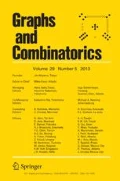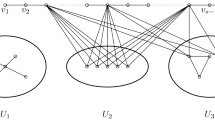Abstract
We are interested in hereditary classes of graphs \({\mathcal {G}}\) such that every graph \(G \in {\mathcal {G}}\) satisfies \(\varvec{\chi }(G) \le \omega (G) + 1\), where \(\chi (G)\) (\(\omega (G)\)) denote the chromatic (clique) number of G. This upper bound is called the Vizing bound for the chromatic number. Apart from perfect graphs few classes are known to satisfy the Vizing bound in the literature. We show that if G is (\(P_6, S_{1, 2, 2}\), diamond)-free, then \(\chi (G) \le \omega (G)+1\), and we give examples to show that the bound is sharp.


Similar content being viewed by others
References
Alekseev, V.E.: On the number of maximal stable sets in graphs from hereditary classes, Combinatorial-algebraic methods in discrete optimization, University of Nizhny Novgorod (in Russian), pp. 5–8 (1991)
Blázsik, Z., Hujter, M., Pluhár, A., Tuza, Z.: Graphs with no induced \(C_4\) and \(2K_2\). Discret. Math. 115, 51–55 (1993)
Beineke, L.W.: Derived graphs and digraphs. In: Sachs, H. (ed.) Beiträge zur Graphentheorie, pp. 17–33. Teubner, Leibzig (1968)
Brandstädt, A., Le, V.B., Spinrad, J.P.: Graph Classes: A Survey. Society for Industrial Mathematics (1999)
Chao, H.S., Hsu, F.R., Lee, R.C.T.: An optimal algorithm for finding the minimum cardinality dominating set on permutation graphs. Discret. Appl. Math. 102(3), 159–173 (2000)
Choudum, S.A.: Chromatic bounds for a class of graphs. Quaterly J. Math. 28, 257–270 (1977)
Choudum, S.A., Karthick, T.: First fit coloring of \(\{P_5, K_4-e\}\)-free graphs. Discret. Appl. Math. 158, 620–626 (2010)
Choudum, S.A., Karthick, T.: Maximal cliques in \(\{P_2 \cup P_3, C_4\}\)-free graphs. Discret. Math. 310, 3398–3403 (2010)
Choudum, S.A., Karthick, T., Shalu, M.A.: Perfect coloring and linearly \(\chi \)-bounded \(P_6\)-free graphs. J. Graph Theory 54(4), 293–306 (2007)
Choudum, S.A., Karthick, T., Shalu, M.A.: Linear chromatic bounds for a subfamily of \(3K_1\)-free graphs. Graphs Comb. 24, 413–428 (2008)
Chudnovsky, M., Seymour, P., Robertson, N., Thomas, R.: The strong perfect graph theorem. Ann. Math. 164(1), 51–229 (2006)
Corneil, D.G., Pearl, Y., Stewart, L.K.: A linear recognition algorithm for cograph. SIAM J. Comput. 14, 926–934 (1985)
Fan, G., Xu, B., Ye, T., Yu, X.: Forbidden subgraphs and 3-colorings. SIAM J. Discret. Math. 28(3), 1226–1256 (2014)
Fouquet, J.L., Giakoumakis, V., Maire, F., Thuillier, H.: On graphs without \(P_5\) and \(\overline{P_5}\). Discret. Math. 146, 33–44 (1995)
Giakoumakis, V., Roussel, F., Thuillier, H.: On \(P_4\)-tidy graphs. Discret. Math. Theor. Comput. Sci. 1, 17–41 (1997)
Golumbic, M.C.: Algorithmic Graph Theory and Perfect Graphs, Annals of Discrete Mathematics, 2nd edn. Elsevier, Amsterdam (2004)
Gravier, S., Hoáng, C.T., Maffray, F.: Coloring the hypergraph of maximal cliques of a graph with no long path. Discret. Math. 272, 285–290 (2003)
Gyárfás, A.: Problems from the world surrounding perfect graphs. Zastosowania Matematyki Applicationes Mathematicae 19, 413–441 (1987)
Huang, S.: Improved complexity results on \(k\)-coloring \(P_t\)-free graphs. Eur. J. Comb. 51, 336–346 (2016)
Karthick, T., Maffray, F.: Weighted independent sets in classes of \(P_6\)-free graphs. Discret. Appl. Math. (2015) (to appear)
Kierstead, H.: On the chromatic index of multigraphs without large triangles. J. Comb. Theory Ser. B 36, 156–160 (1984)
Kierstead, H., Penrice, S.: Radius two trees specify \(\chi \)-bounded classes. J. Graph Theory 18, 119–129 (1994)
Kierstead, H., Schmerl, J.: Some applications of Vizing’s theorem to vertex colorings of graphs. Discret. Math. 45, 277–285 (1983)
Kloks, T., Müller, H., Vusković, K.: Even-hole-free graphs that do not contain diamonds: a structure theorem and its consequences. J. Comb. Theory Ser. B 99, 733–800 (2009)
Korobitsyn, D.V.: On the complexitity of determining the domination number in monogenic classes of graphs. Discret. Math. Appl. 2(2), 191–199 (1992)
Lokshtanov, D., Vatshelle, M., Villanger, Y.: Independent set in \(P_5\)-free graphs in polynomial time. Proc. ACM SIAM Symp. Discret. Algorithms SODA 2014, 570–581 (2014)
Maffray, F., Preissmann, M.: Linear recognition of pseudo-split graphs. Discret. Appl. Math. 52, 307–312 (1994)
Mycielski, J.: Sur le coloriage des graphes. Colloq. Math. 3, 161–162 (1955)
Ramírez-Alfonsín, J.L., Reed, B.A. (eds.): Perfect Graphs. Wiley Interscience, New York (2001)
Randerath, B.: The Vizing bound for the chromatic number based on forbidden pairs. PhD thesis, RWTH Aachen, Shaker Verlag (1998)
Randerath, B.: 3-Colorability and forbidden subgraphs. I: characterizing pairs. Discret. Math. 276, 313–325 (2004)
Randerath, B., Schiermeyer, I.: Vertex colouring and forbidden subgraphs—a survey. Graphs Comb. 20, 1–40 (2004)
Randerath, B., Schiermeyer, I.: 3-Colorability in \(P\) for \(P_6\)-free graphs. Discret. Appl. Math. 136, 299–313 (2004)
Seinsche, D.: On a property of the class of \(n\)-colorable graphs. J. Comb. Theory Ser. B 16, 191–193 (1974)
Sumner, D.P.: Subtrees of a graph and the chromatic number. In: The Theory and Applications of Graphs, Kalamazoo, Michigan, 1980, pp. 557–576. Wiley, New York (1981)
Trotignon, N., Vusković, K.: A structure theorem for graphs with no cycle with a unique chord and its consequences. J. Graph Theory 63, 31–67 (2010)
Vizing, V.G.: On an estimate of the chromatic class of a p-graph (in Russian). Diskret. Analiz. 3, 25–30 (1964)
West, D.B.: Introduction to Graph Theory, 2nd edn. Prentice-Hall, Englewood Cliffs (2000)
Acknowledgments
The authors thank the anonymous referees for their suggestions and comments.
Author information
Authors and Affiliations
Corresponding author
Additional information
Frédéric Maffray: Partially supported by ANR project STINT under reference ANR-13-BS02-0007.
Rights and permissions
About this article
Cite this article
Karthick, T., Maffray, F. Vizing Bound for the Chromatic Number on Some Graph Classes. Graphs and Combinatorics 32, 1447–1460 (2016). https://doi.org/10.1007/s00373-015-1651-1
Received:
Revised:
Published:
Issue Date:
DOI: https://doi.org/10.1007/s00373-015-1651-1




